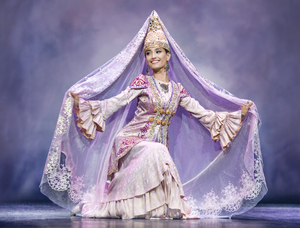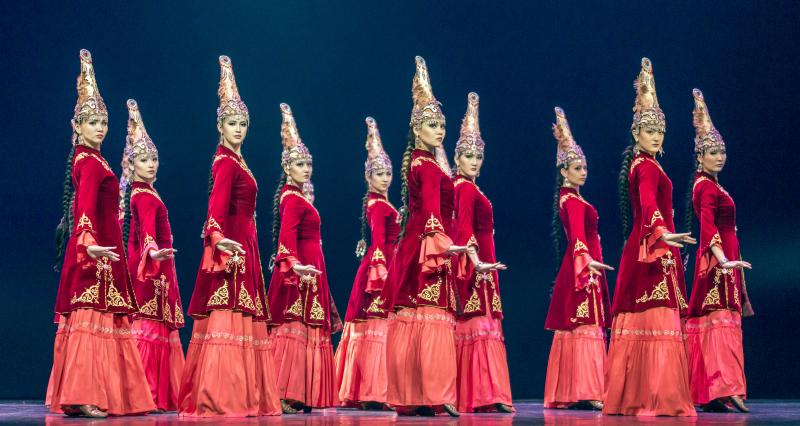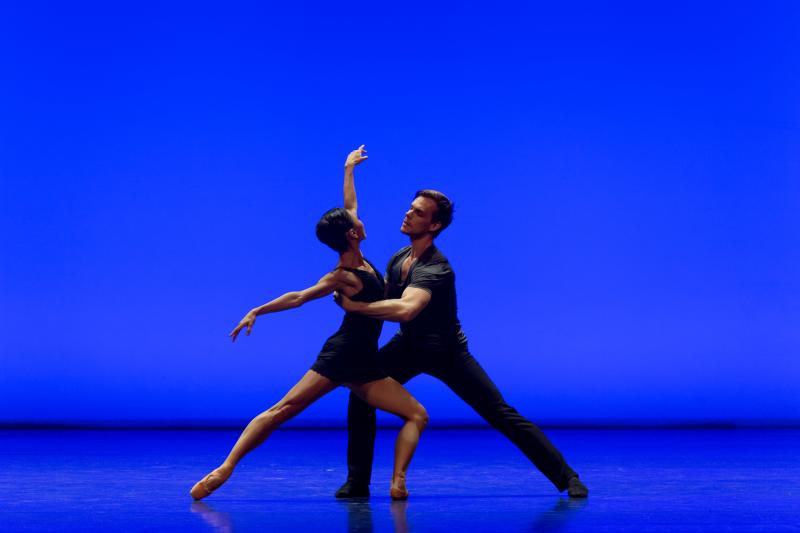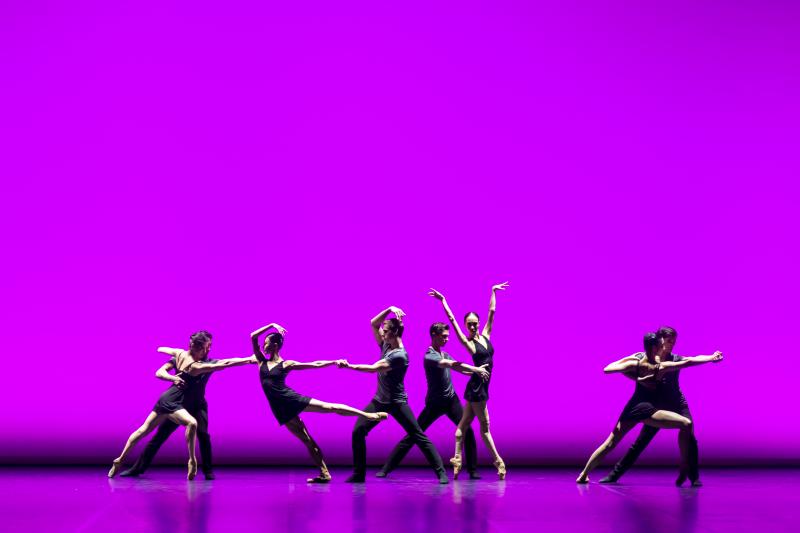Review: THE ASTOUNDING ASTANA BALLET at The Saban Theatre

November 22, 2019
Astonishing in their choice of repertoire, their innovative choreography, their elaborate and colorfully creative costuming and their commanding performance of the choreography.
Don't let this first photo confuse you. This Company is so many things, and the picture represents but one facet of their dance works ~ I just had to use it for the beauty and uniqueness of it and the elaborate costuming.
The evening commenced with a sextet of pieces that were entitled The Heritage of the Great Steppe, following the history and traditions of the Kazakhstan people. Beautifully executed and visually stunning, each one was unique.
The first piece, entitled "ARULAR," or "Procession of Beauties," was simply magical as the full company of dancers entered in magnificent red silk and resplendent gold costumes, with amazingly high headdresses, scarves flowing, seemingly floating onto and around the stage to waltz-tempoed music by Turan in intricate formations, choreographed by A. Tati; truly a regal visual to behold. The company's preciseness of movement in unison made for a feeling of royal traditional reverence. 
"AKKYZ," "Charming tenderness," danced to Kavakh folk music, also choreographed by A. Tati, performed by D. Kairasheva, was a lovely, soft ballet solo, very swan-like movements, fluttering and grand jetteing to plucking mandolins as she arched her back in captivating feminine poses. In her long white flowing skirt and long braid all the way down her back, she emanated gentleness and poise.
Thunderclaps abounding, "SCYTHIAN MURAL," began with a jolt of energy. I could say men in skirts, but this was an awesomely impactful piece of theatre. The men, shirtless, with long, black, impressively-designed long skirts, in sections, or panels, spun onto stage, one by one, to oriental-sounding music, "Chermirani," and held court in a very strong, impressive men's section to the beat of conga drums ~ I was impressed with the clean and somewhat Egyptian-styled lines the dancers maintained throughout.
A pas de deux followed, cleverly costuming the female dancer in a nude leotard, as to aesthetically match the male dancers, which was set to a very intense, upbeat tempo, lights flashing with a strobe-like effect, energy abounding; again, clean, sharp and precise lines, concluding with the nine male dancers reentering to bring everything to a feverish end. Intricate choreography set by M. Avakhri. 
"ASEM KONYR" is dedicated to the Women of the Great Steppe. "Wise, calm and kind." The music, by D. Nurpeisova, and choreography, by A. Tati, blended together nicely, with congas slowly gaining tempo as twelve splendidly costumed ladies, again, very elegant, with gold-trimmed red velvet coats, long pink skirts underneath, circled around the stage, then breaking out into picture-perfect poses, giving much feminine attitude, and also giving the simple but effective choreography a lot of mileage. Beautifully performed.
Coming next, "THE SPIRIT OF THE STEPPE", Music by "Hassak," an ethno-folklore ensemble, choreography by A. Tati, and featuring Milana Bukanova, Assel Zhangaskaeva and Aiinur Abilgazina was a vibrantly-colored, energy-laced dance, with precise and over-extended grand jete's, Milana tapping the back pointed toe to the back of her head each time, in a swirl of orange shades, highlighting the back scrim of deep orange, the costuming as the orange dresses with skirts were twirled, revealing the the under-skirt of royal blue really setting the tone for the piece. The "Crown of Orange" was placed properly at the end.
Ending this section, "ULY DALA," "Motherland," was a pull out the stops, everything-in-one number. Congas and mandolins again pounding and plucking, building to a wild pitch, the men lifting each other, doing acrobats and walkovers, costumed in armor and helmets, while a flute trills to the amplified drumbeats. The trio of dancers downstage leapt in the air with ease, and the entire company was sharp and full of enthusiasm, working full out, with purpose. The men's sections in particular were strong and impressive. The costuming was so creative with color schemes and types of fabric bringing out different shades and hues. Through many sections of trios, solos and duets, mingling different formations together with precise accuracy, the ladies en pointe effortlessly maneuvering a quadruple pirouette, very lovely spins, pirouettes into an arabesque, to back attitude, all the while with beautiful port de bras accompanying their movements. Culminating with a triumphant high-in-the-air, stunning lift as the female dancer extensively, slowly, arches back on exit.
 "Love's Lost Idols" is the first of three One-Act Ballets that followed. Beginning with a series of lifts that two male dancers did with one female dancer across the floor, clothed in beautiful olive green tones that was a thing of beauty, how she seemed to have the flexibility of a rubber band, being passed from male dancer to male dancer, overhead in a lift, or in between them performing a walkover; not to mention the most gorgeous extension! All the lifts were creatively devised, unusual types of lifts not seen very often, and all so well performed.
"Love's Lost Idols" is the first of three One-Act Ballets that followed. Beginning with a series of lifts that two male dancers did with one female dancer across the floor, clothed in beautiful olive green tones that was a thing of beauty, how she seemed to have the flexibility of a rubber band, being passed from male dancer to male dancer, overhead in a lift, or in between them performing a walkover; not to mention the most gorgeous extension! All the lifts were creatively devised, unusual types of lifts not seen very often, and all so well performed.
Each section, grouping or piece throughout the rest of the performance had a different color scheme to their wardrobe, either very vibrant or, muted shades of one color, each section a little differently designed. It added much to the feel of each.
Ezio Bosso's Music (String Quartet No. 5 "Music for the Lodger") evoked the awareness of the transience of Life, in all its' ups and downs, strength, passion, risk and fearlessness, sacrifice and enjoyment. A pas de deux, the violin and cello melody building through the piece, taking us through a pause while all the dancers posed along the upstage backdrop, painting a beautiful artistic picture, then to a fierce solo danced by a soft wisp of a dancer, who seemed to float on air; barefoot and surefooted, with an inner strength that defied her frame; more combinations, formation changes and lifts, another male dancers' section, a male soloist who spun, did floor work and a double tour en la air with such ease and grace; ending intensely, the dancers filled with emotion, fouettes, fan kicks, wildly bouree'ing until one at a time, each girl is lifted in the air, and all settle into an ending pose.
The wonderful Choreography was by Nicolo Fonte, Scenic and Lighting Design by Michael Mazzola, and the fabulously artistic Costuming by Christine Darch, were all nicely tied together. The very clean and precise Dancers as partners: Aizhan Mukatova/Angsagan Kobentay, Tatiana Ten/Ainur Abilgazina, Angsagan Kobentay/Dilara Shomayeva, Kalamkas Orynbasarova/Paula Rosa Santana, Anar Dukiyeva/Diana Battyrova; Farkhad Buriyev/David Jonathan, Ilya Manaenkov,/Baikhadam Tungatarov, Artur Edson/Sundet Sulatnov. 
The next One-Act Ballet was entitled "Love Fear Loss," inspired by the extraordinary life and delightful music of Edith Piaf, covering the stages of love in her life, hence the title. Accompanied only by piano, (a bit overwhelming in volume at this performance) the different couples performed to the lyrics and voice of the unique Ms. Piaf, exuding passion and romance.
Filled with effortless and unusual lifts, occasionally tossing a dancer into the air, having her land neatly near the ground, right into another lift en attitude, the dancers were lithe and airy, in contrast with the intense melodies penned by Edith Piaf, Charles Dumont and Jacques Brel, of course. The Libretto, Choreography and Costumes are credited to Ricardo Amarante. The strains of " La Vie En Rose," "Ne me Quitte Pas'" and "Mon Dieu" were done justice through the sweeping movements of the dancers; feeling every emotion. The first section of dancers included Nazerke Aimukhametova/Dilara Shomayeva, David Jonathan/Sunde4t Sultanov; the second section of trios: Ainur Abilgazina/Aizhan Mukatova/DilaraShomayeva and Ilya Manaenkov/Sundet Sultanov/Baurzhan Mekembayev, the last section: Tatyana Ten/Aimur Mukatova/Nazerke Aimukhametova and Farkhad Buriyev/Ilya Manaenkov.
 "A Fuego Lento," the last One-Act Ballet, was musically an interesting combination of composers; Lalo Shifrin, Astor Piazzolla, Carlos Gardel and Sayo Kosugi. The Choreography was stunning, as well as the Costume Design, both by Brazilian Ricardo Amarante. These choices reflect the broad diversity of Kasakhstan's long and varied history. The original premiere of this piece was performed in Tokyo, Japan, on October 5th, 2016. The pounding of drums, as the dancers hit different poses in couples, then a loud bang, started the music, first a mixture of violins and accordion in a minor key, kicking off a brilliant, seductive, tango, danced in couples, with the entire cast taking part. Carlos Gardel's familiar tango "Por Una Cabeza," was perfect accompaniment as the dancers switched from jazz positions, to quick, sharp tango combinations, to a Rondo; the men, in black costuming, promenading the lovely ladies, again en pointe, in darling little black dresses as they all kept in motion constantly. Spectacular lifts to a violin solo, glorious slow developpe's, the lighting shifting to dimly lit as a bassoon pizzicatoed it's way through the melody; many different moods, music and dance styles were portrayed, all to perfection.
"A Fuego Lento," the last One-Act Ballet, was musically an interesting combination of composers; Lalo Shifrin, Astor Piazzolla, Carlos Gardel and Sayo Kosugi. The Choreography was stunning, as well as the Costume Design, both by Brazilian Ricardo Amarante. These choices reflect the broad diversity of Kasakhstan's long and varied history. The original premiere of this piece was performed in Tokyo, Japan, on October 5th, 2016. The pounding of drums, as the dancers hit different poses in couples, then a loud bang, started the music, first a mixture of violins and accordion in a minor key, kicking off a brilliant, seductive, tango, danced in couples, with the entire cast taking part. Carlos Gardel's familiar tango "Por Una Cabeza," was perfect accompaniment as the dancers switched from jazz positions, to quick, sharp tango combinations, to a Rondo; the men, in black costuming, promenading the lovely ladies, again en pointe, in darling little black dresses as they all kept in motion constantly. Spectacular lifts to a violin solo, glorious slow developpe's, the lighting shifting to dimly lit as a bassoon pizzicatoed it's way through the melody; many different moods, music and dance styles were portrayed, all to perfection.
 The dancers got a chance to let loose, dancing modern steps, using opposition in their body movements as the music kept intensifying, upbeat in tempo, getting crazy, even cacaphonic. There were more mouth-dropping lifts, executed each time beautifully, high kicks, double pirouettes en la air, fouette's, all as the music hastened, moving to a seductive conga rhythm where they challenged each other with more feats of strength, the lighting constantly changing to match the dancers' costuming, sometimes putting the dancers, effectively, in silhouette. The backdrop changed to red as they concluded the number, went into their elaborate bows, and then kept dancing! An energetic men's section began, with the ladies then countering them to a gigue-like piano solo, with the audience clapping profusely, in appreciation; it was more like a celebration than anything else, at that point!
The dancers got a chance to let loose, dancing modern steps, using opposition in their body movements as the music kept intensifying, upbeat in tempo, getting crazy, even cacaphonic. There were more mouth-dropping lifts, executed each time beautifully, high kicks, double pirouettes en la air, fouette's, all as the music hastened, moving to a seductive conga rhythm where they challenged each other with more feats of strength, the lighting constantly changing to match the dancers' costuming, sometimes putting the dancers, effectively, in silhouette. The backdrop changed to red as they concluded the number, went into their elaborate bows, and then kept dancing! An energetic men's section began, with the ladies then countering them to a gigue-like piano solo, with the audience clapping profusely, in appreciation; it was more like a celebration than anything else, at that point! 
A stunning, fantastic evening presented by the Astana Ballet Company! They have amassed an amazing repertoire.
The magic of movement, and not using a single word of dialogue, is a truly beautiful way for different cultures to share universal feelings and emotions; to connect with the heart and soul in us all.
Here's hoping The Astana Ballet will be coming back to Los Angeles again, and sticking around for a longer-than-one-night run.
Photos courtesy of Astana Ballet Company
Reader Reviews

Videos
